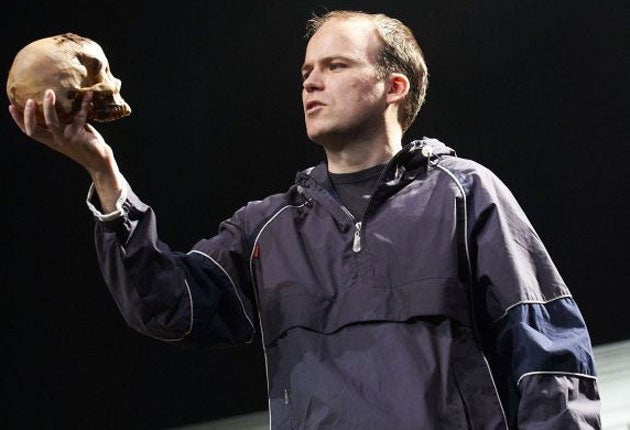Susie Rushton: A shuffler's guide to theatre etiquette
Notebook

That member of the audience, the woman who's been shuffling in her seat just down the row from you, her with the twitchy legs, the same woman who dropped her water bottle on the floor, twice, asked the man sitting next to her: "Was he in a sitcom?" "Morse?" That's me.
And now, right the middle of Act Two, that woman has decided to creep out of the auditorium to the lavatory. This is ill-advised. Leg room is cramped up in the Circle. She's standing up in the darkness, trying to grope her way along the row, and people are having to fold up their legs to let her past. This isn't a cinema, for goodness' sake, this is live theatre, the National Theatre, no less, and this is Hamlet – no, no – not just Hamlet, but four-out-of-five-stars Hamlet! Yes, we may be in the cheap seats, but a certain level of decorum is expected.
Clearly, I don't really understand the rules of going to the theatre; am I supposed to dress up? Is it rude to eat snacks? Do I have to clap through all the endless bowing at the end, or can I just applaud the actors I like? The whole experience, while enjoyable, is just a little stressful. But my greatest concern is that I'll need the bathroom and find myself stuck in the middle of a row. Stuck there, legs crossed, the whole play will then be ruined by the urge to go: "Frailty, thy name is urine," I'll hear Hamlet snarl. "To pee or not to pee," he seems to say, a few scenes later. Which can rather spoil things.
You'd think that my fellow theatregoers at the Saturday matinee, most of whom were of pensionable age, would be sympathetic. But this was a stoic crowd. For three-and-a-half hours, they stuck it out, peering at the faraway stage in silence, soaking up Shakespearean misery and misogyny and even Ophelia's embarrassing "madness".
This audience also knew what to do in the interval. I'm naive enough to believe that the interval is an actual break, giving you time to not only go to the bathroom, but buy an ice cream, maybe sit down and eat it, then wander back to the auditorium at leisure. But it just isn't. There's time to rush outside, get in a queue, watch on as half-a-dozen Home Counties women cut in ahead of you because they "only want a coffee" (how can they drink coffee? Do they pee into their Radley handbags?), choke down a lemon polenta cake as the bell sounds, signalling that you must be back at your seat in one minute.
One day, when I grow up, I'll be a good theatregoer. Too many DVD box sets and the comfy cinema experience have made me undisciplined for the rigours of live action drama. Or could it be that theatre itself has become too uptight? If I were at the Globe in 1601, nobody would care if I stood up in the middle of the play, heckled Ophelia, clambered over the benches to take a pee in the Thames, then noisily returned to my seat, asking anyone who'd listen: "That bald guy playing Claudius – wasn't he in Bergerac?"
Back in time for a 25th anniversary
Back in the less civilised surroundings of the cinema, this week I climbed into the silver DeLorean of my imagination and travelled back in time to 1985 to revisit one of the greatest movies of that decade, currently on limited release to celebrate its 25th anniversary. Forget Wall Street and its theme of material gain at all costs – it was Back to the Future that really impressed me as a legwarmer-clad kid. Who can't fail to be moved by its messages that, erm, skateboarding is cool, electric guitars are cool, Huey Lewis and the News are cool, but accidentally snogging your mum really isn't? Suitably enough, for a movie about time travel, it is well-preserved, although Michael J Fox's precise vintage at the time of filming remains baffling. A 24-year-old, playing a 16-year-old high-school student – somehow the baby-faced actor overcompensates, goes back in time too far, and ends up looking like an eight-year-old boy with crow's feet. In today's Hollywood, enhanced by digital tweaking and Botox, they'd never let that happen.
A darling dame who was no diva
Among her many talents, the late Dame Joan Sutherland managed to be that rare thing: a woman who refuses to fit a popular cliché. As the universe knows, female opera singers are supposed to be enormously fussy brats who must be cosseted and complimented at every turn in case they explode with neurotic fury. They need bunches of flowers and pink loo roll and lots of pills to keep them calm. Sutherland may have been a dame, but those who knew say she was quite without the characteristics commonly given to that other "d" word you'd think would apply: she was no diva.
The music critic Norman Lebrecht described Sutherland as a "simple, friendly woman, happiest in a dressing room with a magazine and her knitting. She avoided tantrums, had no airs and graces, and in retirement shunned the limelight." What? A prima donna – one nicknamed La Stupenda, no less – who didn't make those around her pay the price for her fame? Is it too late to reclaim the word "diva" – meaning, simply, a female singer, rather than a spoilt cow – from Mariah Carey and Katie Price, from Naomi Campbell and, surely, please God, those boys Diva Fever ...

Join our commenting forum
Join thought-provoking conversations, follow other Independent readers and see their replies